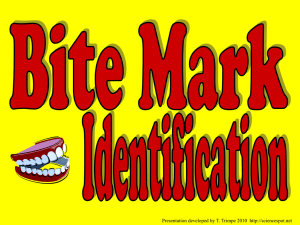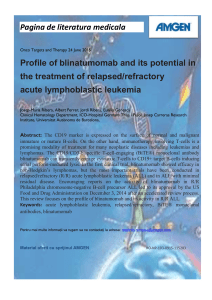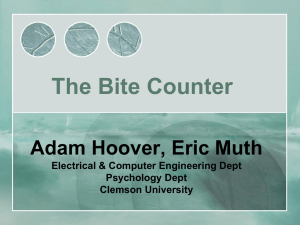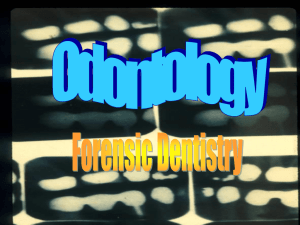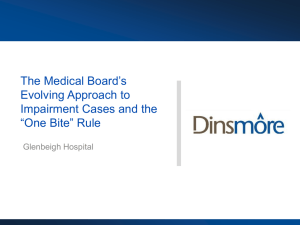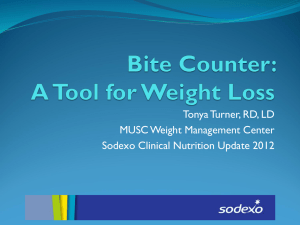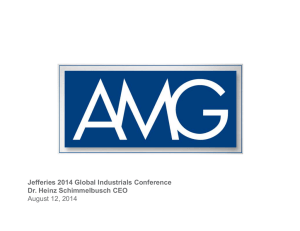Tumor Immunotherapy with BiTEs
advertisement
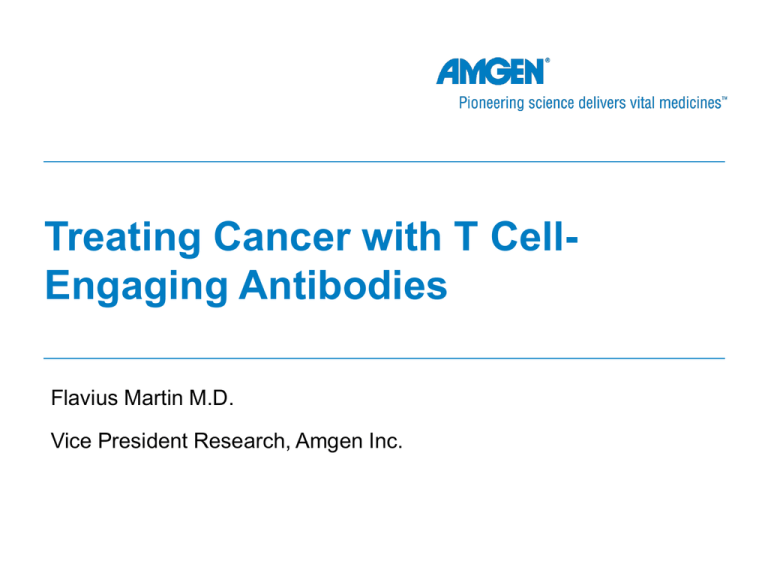
Treating Cancer with T CellEngaging Antibodies Flavius Martin M.D. Vice President Research, Amgen Inc. T cell Tumor Immunotherapy Players Tumor Cell Antigens: - Surface/Presented BiTE® - Cell autonomous functions T cells: - Response tuning - Effector function For Internal Use Only. Amgen Confidential. 2 BiTE® Engineering an Adapter From Two Monoclonal Antibodies BiTE® = Bispecific T Cell Engager Tumor Cell-specific Antibody BiTE® T Cell-specific Antibody Single-chain Antibody 1 VH VH VL VL Linker Single-chain Antibody 2 3 BiTE® Antibodies May Circumvent Frequent Escape Mechanisms Any T Cell CD3e Do not Require T Cell Clone With Specific T Cell Receptor Do not Require MHC Class I and Peptide Antigen for Recognition by T Cell Can Make Any T Cell Recognize a Surface Antigen TCR X X BiTE® Antibody CD19 EpCAM CEA PSMA Tumor Cell 4 A549 Lung Cancer Cells Peacefully Coexist With T Cells Cancer Cell Resting CD8+ T Cell A549 Lung Cancer Cell: T Cell Ratio = 1:1 5 Each T Cell Can Kill Nearby Cancer Cell After BiTE® AMG 110 Is Added Apoptotic Cancer Cell T Cell Alive Cancer Cell -EpCAM -CD3 6 Kinetic Analysis of in-vitro BiTE® Reaction With Unstimulated T Cells AMG 330 = CD33/CD3-bispecific BiTE®; unstimulated human PBMC as effector cells at 10:1 ratio T cell potency increases over time by 1-2 logs 28h Complete lysis 22h 16h 10h AMG 330 [ 7 Unstimulated T cells show lag phase before they start killing Most Subpopulations of T Cells Can Contribute to Lysis by BiTE in vitro Kischel, R. et al., poster at AACR 2009 Relative Potency of Redirected Lysis T Cell Populations Studied Marker CD8+ Bulk CD8+ +++ CD8+ Naïve CD28+ / CD45RA+ -/+ CD8+ EM CCR7- / CD45RA- ++++ CD8+ EMRA CD28- / CD45RA+ +++++ NKT Cells CD3+ / CD56+ ++ g/d T Cells CD3+ /b - + CD4+ Bulk CD4+ ++ CD4+ Naïve CD4+ / CD45RO- -/+ CD4+ EM CCR7- / CD45RA- +++ CD4+ EM+CM CD4+ / CD45RA- ++ CD4+ Naïve, Stimulated CD69, CD25 +++ CD4+ EM, Stimulated CD69, CD25 +++ 8 Blinatumomab (AMG 103), a CD19/CD3bispecific BiTE® Antibody • Murine antibody construct of 55 kDa produced by CHO cell-based process • CD19 target is diagnostic marker for B cell malignancies – 100% of ALL cases are positive for CD19 – Expressed on leukemic stem cells with self renewal capacity – CD19 is activator of PI3 kinase • Serum half life of AMG 103 is 1-2 hours continuous i.v. infusion using port/minipump • Multiple clinical trials in adult and pediatric ALL patients; NHL experience N KD = 10-9 M -CD19 KD = 10-7 M -CD3 9 C CD19-BiTE - Response and HSCT n/N 95 % CI Primary endpoint CR/CRh during the first two cycles 81 / 189 43% 36–50 Exploratory endpoints MRD response during the first two cycles CR/CRh 60 / 73 82% 72–90 CR, complete remission; CRh, complete remission with partial hematological recovery of peripheral blood counts; MRD, minimal residual disease (< 10-4) Activity of Blinatumomab in NHL Patients Is Dosedependent (Phase 1 Study AMG 103-104) 12x higher dose needed for tumor Peripheral T Cell Redistribution Complete and Sustained B Cell Depletion Bone Marrow Clearance; First PR/CR High RR 0.5 5 1.5 15 30 60 Dose Levels Tested [µg/m2/Day] 11 90 Preliminary Learnings From Blinatumomab Monotherapy about BiTE® Modality • Need only very low doses – High response rates in ALL patients at steady state serum levels of 0.5 to 1 ng/ml (<18 pM); cumulative doses of low milligrams per cycle • Eliminates proliferating and nonproliferating target cells – Potential to eliminate dormant cancer stem cells • Activity in many locations of body – Antitumor activity seen in blood, bone marrow, lymph nodes, spleen, lymphoma tissue, liver tissue • Activity in patients who have exhausted all established therapies, including rituximab regimen and SCT • Activity in elderly and pediatric patients • Activity in severly immunocompromised patients – Observed complete response in patients with low to undetectable peripheral T cell counts 12 Other BiTE® Antibodies in Development Clinical Phase 1: • Solitomab (AMG 110: EpCAM) – Advanced solid tumors • AMG 212 (BAY2010112: PSMA) – Prostate cancer • AMG 211 (MEDI-565: CEA) – Advanced GI cancers Pre-clinical: • AMG 330 (CD33) – Acute myeloid leukemia (AML) • Multiple myeloma BiTE -• Solid tumor BiTE® – 13 Extending Immunotherapy Response and Utility Liquid tumors Naked Antibodies Solid tumors Antigens T cell modulators ADCs ADCs BiTEs BiTEs Tumor antigens Biodistribution Combos Antigens Longer half life Combos T cells TCR-derived constructs Intracellular antigens T cellular therapies T cellular therapies Vaccines 14 Appendix 15 Blinatumomab 28 μg/day cIV infusion 4 weeks on, 2 weeks off cIV infusion 4 weeks on, 2 weeks off Up to 2 cycles Up to 3 cycles Primary endpoint assessment Consolidation Study Endpoints HSCT Offered to Patients in CR/CRh (up to 24 months) Blinatumomab 28 μg/day* Follow-up Screening and Enrollment Confirmatory Open-label, Single-arm, Multicenter Phase 2 Study Primary • CR/CRh during the first two cycles Secondary included • CR, CRh • Relapse-free survival • Overall survival • HSCT realization • Incidence of adverse events Exploratory included • Minimal residual disease response by PCR during the first two cycles *Only cycle 1, days 1 to 7: 9 μg/day CR, complete remission; CRh, complete remission with partial hematological recovery of peripheral blood counts (platelets > 50,000/μl and ANC > 500/μl) cIV, continuous intravenous; HSCT, hematopoietic stem cell transplantation Probability of Overall Survival CD19-BiTE in ALL - Overall Survival 1.0 Overall Survival N=189 0.8 Median OS, months 0.6 95% CI, months 0.4 4.2–7.5 0.2 0 0 2 Patients at Risk 189 139 Probability of Overall Survival 6.1 4 6 8 10 Months 12 14 16 18 104 72 44 27 21 10 6 0 1.0 20 Overall Survival Landmark Analysis Day 77* 0.8 CR/CRh No CR/CRh N=79 N=50 Median OS, months 9.9 2.7 95% CI, months 6.8–NE 1.6–4.5 0.6 0.4 0.2 0 0 2 4 6 8 12 14 16 Patients at Risk 79 68 50 26 10 Months 43 15 33 9 21 5 12 4 8 2 5 1 0 0 *After two treatment cycles NE, not estimable 18 20
